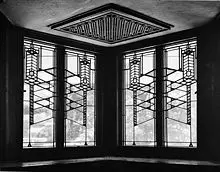 Charles Rennie Mackintosh: Music Room, 1901
Charles Rennie Mackintosh: Music Room, 1901
Interior architecture is an art that brings buildings to life from the inside out. It involves both the initial design and the later adaptation of a building's interior to meet changing needs. From sustainable practices to the consideration of human use, interior architecture encompasses all aspects of designing spaces that are both functional and beautiful.
The Significance of Adaptive Reuse
 Interior of architect Frank Lloyd Wright's Robie House, (1911) designed by interior architect George Mann Niedecken
Interior of architect Frank Lloyd Wright's Robie House, (1911) designed by interior architect George Mann Niedecken
One noteworthy aspect of interior architecture is adaptive reuse. This process involves the significant redesign of a building's interior to repurpose the structure for a different use. It allows for the preservation of existing resources by breathing new life into old spaces. Examples of successful adaptive reuse projects, such as the Battersea Power Station in London and Gasometer City in Vienna, demonstrate the potential of this approach.
The Impact of Sustainability
 The World Food Prize Hall of Laureates, formerly the Des Moines Public Library
The World Food Prize Hall of Laureates, formerly the Des Moines Public Library
In recent years, sustainability has become a central focus in interior architecture. Designers aim to minimize their impact on the environment by using eco-friendly materials and implementing energy-efficient concepts. This shift has led to the development of new technologies and materials that combine aesthetic design with environmental responsibility. Sustainable design is now recognized as a preferred and desirable approach in the field.
Education in Interior Architecture
 Rhode Island School of Design
Rhode Island School of Design
To become an interior architect, one must possess a deep understanding of historical architectural styles, building codes, and safety regulations. Education in interior architecture encompasses a wide range of topics, from preserving and restoring old buildings to creating original designs and models. Degree programs in interior architecture equip students with the necessary knowledge and skills to excel in the field.
The Difference Between Interior Architects and Designers
Interior architects and designers play distinct roles in the world of interior design. While interior architects focus on the structural aspects of a space, including space planning and exterior design, interior designers emphasize aesthetics and furnishings. However, there is often an overlap between the two professions, with both contributing to the overall design and functionality of a space.
Exploring Architectural Styles
 Gothic Architecture
Gothic Architecture
Architectural styles have evolved over time, reflecting changing societal values and technological advancements. From the intricate Gothic architecture of the past, with its pointed arches and stained glass windows, to the maximalist and ornate Victorian era, and finally to the minimalist and functional modern architecture of today, each style has left its mark on the world of interior design.
Interior architecture is an ever-evolving field that combines the art and science of designing functional and aesthetically pleasing spaces. From adaptive reuse to sustainability, interior architects play a crucial role in shaping the built environment. By understanding the history and principles of different architectural styles, they create spaces that not only meet human needs but also inspire and delight.












